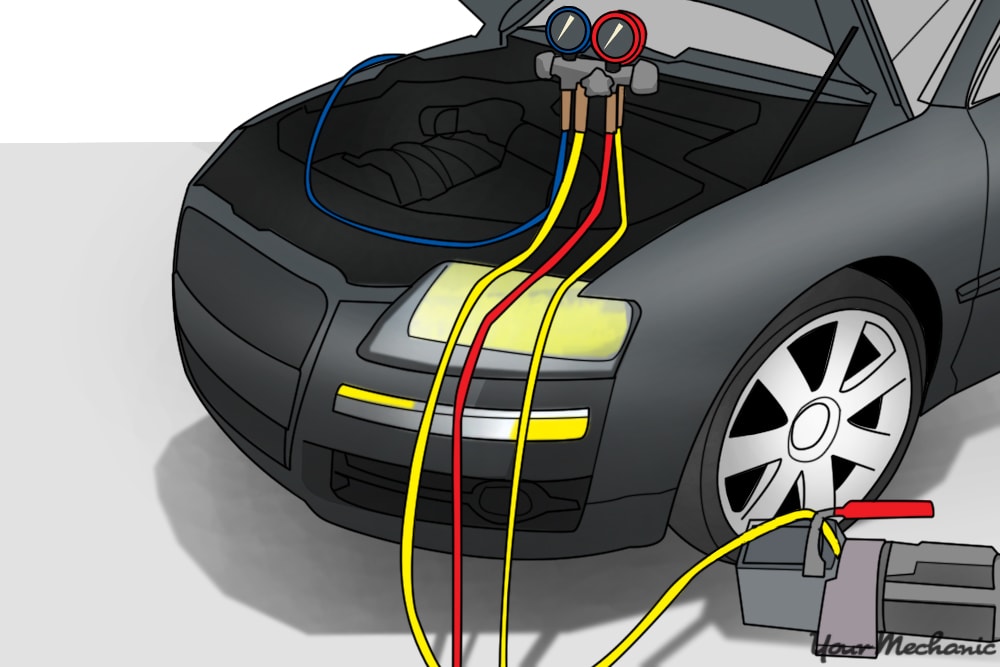To remove Freon from a car using a vacuum pump, first ensure the car’s engine is off and then connect the pump to the low-pressure service port.
Draw Freon into a recovery tank by creating a vacuum in the car’s air conditioning system.
Removing Freon, or refrigerant, from a car’s air conditioning system is a task that requires precision and adherence to environmental regulations.
This process, commonly known as refrigerant recovery, involves using a vacuum pump to ensure the Freon is safely extracted without releasing it into the atmosphere.
Introduction To Car Ac Systems And Freon
Welcome to the intricate world of car AC systems and their essential coolant, Freon. A car’s air conditioning system offers much-needed relief on hot days, with Freon playing a critical role.
This introduction peels back the layers of your vehicle’s cooling mechanisms, highlighting how to responsibly and efficiently remove Freon using a vacuum pump.
Understanding The Role Of Freon In Vehicle Air Conditioning
Freon, widely recognized as the lifeblood of car AC systems, serves as a refrigerant.
- Circulates through coils
- Absorbs heat from the car’s interior
- Releases heat outside
Without Freon, your car’s AC can’t produce cold air.
Legal And Environmental Considerations Of Handling Freon
Dealing with Freon is not a do-it-yourself task.
Many countries regulate Freon removal due to its environmental impact.
| Consideration | Details |
|---|---|
| Legislation | Strict laws govern handling and disposal |
| Environmental Impact | Freon can deplete the ozone layer |
| Professional Support |
Qualified technicians must perform the removal |

Credit: www.amazon.com
Safety First: Preparing To Work With Refrigerants
Dealing with refrigerants, like Freon, is no child’s play.
Before attempting to remove Freon from your car using a vacuum pump,
understanding safety protocols is crucial.
Personal protective equipment is a must.
Let’s dive into the details of staying safe while managing Freon.
Personal Protective Equipment (ppe) For Handling Freon
Safety gear is essential when working with refrigerants.
Avoid skin contact and inhalation.
- Gloves: Wear nitrile gloves to protect your hands.
- Goggles: Use safety goggles to shield your eyes.
- Respirator: Consider a respirator for adequate breathing protection.
- Apron: Don a sturdy apron to protect your clothes and skin.
Understanding The Risks Of Freon Exposure
Freon exposure poses serious health risks.
| Exposure Type | Potential Health Risks |
|---|---|
| Skin Contact | Frostbite and irritation |
| Inhalation | Respiratory issues and toxicity |
| Eye Contact | Corneal frostbite |
Immediate action is vital if exposed.
Flush your eyes with water, remove contaminated clothing, and seek medical attention.
Essential Tools For Freon Removal
Essential tools are crucial for properly removing Freon from your car. Before tackling this task, let’s ensure you have everything needed for a safe and successful extraction.
Undoubtedly, one major player in this process is the vacuum pump, but there are other vital tools and equipment as well.
Overview Of A Vacuum Pump And Its Role In Freon Removal
At the heart of Freon removal sits the vacuum pump. This tool draws out Freon and air from your car’s air conditioning system. It is essential for maintaining a healthy AC system by preventing moisture and non-condensables that can lead to corrosion and inefficiency.
Additional Required Tools And Equipment
To support the vacuum pump’s work, you need a combination of tools. With the right setup, you can remove Freon safely and efficiently. Your toolkit should include:
- Service manifold gauge set: Allows monitoring of pressure within the system.
- Refrigerant recovery system: Stores Freon during removal.
- Recovery cylinder: A safe container for holding the refrigerant.
- Refrigerant scale: To measure the amount of Freon removed.
- Protective gear: Safety glasses and gloves are a must.
- Wrenches and pliers: For loosening and tightening fittings.
- Leak detector: Identifies any breaches in the system post-operation.
Each item plays a part in a successful removal process. For example, the gauge set gives insight into when your system is fully void of Freon and air, guiding the vacuum pump’s operation.
Step-by-step Guide To Removing Freon With A Vacuum Pump
Removing Freon from a car’s AC system requires precision and care. This step-by-step guide will walk you through the process using a vacuum pump, ensuring your vehicle’s AC maintenance is done safely and effectively.
Locating The Service Valves On Your Ac System
Service valves are critical for safely handling Freon. Find the high-pressure and low-pressure valves. They’re often marked with colors: red for high and blue for low.
- Check the user manual for specific locations.
- Wear safety glasses and gloves at all times.
- Ensure the car engine is off and cooled down.
Connecting The Vacuum Pump And Gauges
Proper setup is key for an effective Freon removal. Ensure all connections are secure for a safe operation.
- Connect the gauge’s blue hose to the low-pressure service valve.
- Attach the red hose to the high-pressure valve.
- Ensure the yellow hose from the gauges connects to the vacuum pump.
- Keep all connections tight to prevent leakage.
Creating A Vacuum And Extracting Freon
A vacuum safely removes Freon from your AC system. Follow these steps to create a vacuum and extract Freon:
- Start the vacuum pump, monitoring the gauges.
- Open both the high and low-pressure valves on the gauge set.
- Let the pump run for 15-30 minutes to create a strong vacuum.
- Observe the gauges for a drop in pressure, indicating Freon extraction.
- Close the valves, turn off the pump, and disconnect the hoses.
Never release Freon into the atmosphere. It’s illegal and harmful. Always recycle or reclaim Freon following EPA regulations.
Best Practices For Freon Capture And Recycling
Best Practices for Freon Capture and Recycling are essential in maintaining an eco-friendly approach. Using a vacuum pump to remove Freon from cars does more than just service the vehicle. It also protects the atmosphere from harmful chemicals. The following guidelines will help ensure the responsible handling of Freon.
Why Recycling Freon Is Crucial For The Environment
Freon, or refrigerant, is a chemical commonly used in air conditioning systems. When released into the environment, it can deplete the ozone layer and contribute to climate change. That’s why capturing and recycling Freon is vital. It reduces ozone depletion and lowers the demand for new, raw refrigerant production.
How To Properly Store And Dispose Of Recovered Freon
- Use approved containers: Store recovered Freon in DOT-certified cylinders.
- Keep containers sealed: Prevent leaks by keeping valves tightly closed.
- Label clearly: Mark containers with the type of refrigerant and the recovery date.
- Recycle or dispose legally: Contact authorized recyclers or disposal facilities for end-of-life management.

Credit: www.yourmechanic.com
Troubleshooting Common Issues During Freon Removal
Troubleshooting Common Issues During Freon Removal can be a tricky part of maintaining your car’s air conditioning (AC) system. Even with a vacuum pump, you might encounter problems like leaks or vacuum pump malfunctions. To ensure a successful Freon removal, let’s dive into the most common issues and their solutions.
Dealing With Potential Leaks And System Contamination
Removing Freon requires a tight seal in the AC system. Leaks can mean Freon escapes, posing environmental risks and system inefficiency. To prevent this:
- Check the connections between hoses and the vacuum pump.
- Use leak detection dye to locate unseen leaks.
- Replace damaged seals or hoses immediately.
System contamination can hinder performance. Dust, debris, or moisture can compromise the system. Use a vacuum pump to remove contaminants and ensure the system is clean before adding new Freon.
Addressing Vacuum Pump Malfunctions
A vacuum pump is essential for removing Freon; malfunctions can stall the process. Common vacuum pump issues include:
| Issue | Solution |
|---|---|
| Inadequate vacuum | Check oil levels and replace if low or dirty. |
| Strange noises | Inspect for loose parts and tighten them. |
| Failure to start | Examine the power supply and connections. |
Always follow the manufacturer’s guidelines when addressing pump malfunctions to avoid further damage or warranty voiding.
Finalizing The Process And Routine Maintenance
After removing Freon from your car using a vacuum pump, it is crucial to finish the process correctly. This ensures your AC system is safe and operational. Proper routine maintenance follows to keep your car’s AC in top shape.
Ensuring All Valves Are Sealed And The System Is Restored
Start by double-checking all connections. Make sure valves are tightly sealed. This prevents leaks. Reconnect any electrical connectors. Replace the service valve caps. Run the AC to test the system. Look for any signs of issues. Address these immediately for a functional AC system.
Regular Maintenance Tips For Your Car’s Ac System
Always stay ahead with routine AC checks. Follow these tips for peak performance:
- Inspect the system yearly.
- Change the cabin air filter regularly.
- Look for leaks and damage routinely.
Schedule professional inspections bi-annually. Keep your AC cool and efficient all year round!

Credit: m.youtube.com
Frequently Asked Questions For How To Remove Freon From Car With Vacuum Pump?
Can I Use A Vacuum Pump To Remove Refrigerant?
No, using a vacuum pump to remove refrigerant violates environmental regulations. You must use a proper refrigerant recovery machine for safe and legal removal.
How Do I Release Freon Pressure From My Car?
Releasing Freon from your car’s AC system requires professional expertise. Take your vehicle to a certified mechanic who will safely discharge the refrigerant. Handling Freon improperly can cause injury and environmental harm.
How Do You Evacuate Refrigerant From A Car?
To evacuate refrigerant from a car, connect a recovery machine to the A/C system’s service ports. Follow the machine’s instructions to safely extract the refrigerant. Ensure the process complies with environmental regulations. Always wear protective equipment during the procedure.
Can I Remove Freon From My Car?
Yes, you can remove Freon from your car, but it requires special equipment. Legally, a certified professional must do this to prevent environmental harm. Do not attempt it without the proper training and tools.
Conclusion
Removing Freon from your car using a vacuum pump is a precise task. Yet, with the right tools and guidance, it’s achievable. Always prioritize safety and legal considerations. Remember, expert assistance ensures proper handling. Ready to tackle other car maintenance projects?
Keep following us for more DIY automotive tips.
When to Replace Ac Compressor in a Car?
Can I Just Replace the Ac Compressor in My Car?
How to Get Tire Shine off Car Paint?





